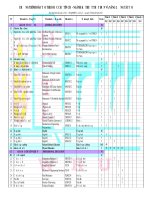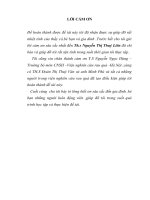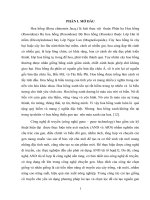tạo hoa hồng xanh bằng kĩ thuật gene
Bạn đang xem bản rút gọn của tài liệu. Xem và tải ngay bản đầy đủ của tài liệu tại đây (1.22 MB, 17 trang )
BLUE ROSE TRANSGENIC
PLANT
Agenda Style
01
Introduction
02
method of gene transfer
03
applying
Our Team
Place Your Picture Here
Ph.D Tran Thi Dung
Van Pham Nhu Ngoc
lecture
student
0587192774
Introduction
In 2004, researchers used genetic modification to
create roses that contain the blue pigment
delphinidin..
01
The blue rose is a flower of the genus Rosa
(family Rosaceae) with the prefix from blue
to purple
02
What is
RNAi is involved in controlling gene activation in the post-
RNAi?
transcription phase
•
RNAi is the process of silencing a gene, inactivating a target gene with a sequence
similar to that of the gene inactivating agent (short strands of RNA about 21-27
nucleotides).
Basic features of the RNAi technique
Specificity, high efficiency, very sensitive.
Inactivates genes of individuals at different stages, inherited from generation to generation,
tissue to tissue.
The dsRNA design is easy if the genome sequence is known.
Method of gene transfer
remove the gene encoding the enzyme
dihydroflavonol reductase (DFR) in roses.
Application of RNAi technology for
S
ES
KN
EA
ST
RE
N
G
TH
S
W
gene replacement in plants
created the 'silencer' gene to exploit a
TH
R
E
AT
S
complete the delphinidin-synthesis reaction.
TU
R
O
PP
O
An iris gene for an enzyme, DFR, required to
ES
TI
I
N
SWOT
cellular phenomenon called RNA
interference (RNAi)
Creating blue roses using RNAi technique
CHU TRÌNH HÌNH THÀNH SẮC TỐ TRÊN CÂY TRỒNG
Anthocyanin dihydrokaempferol enzyme controls
all three cycle of plant pigment formation
including: cyanidin, pelargonidin and delphinidin.
RNAi technique to inhibit the activity of the DFR gene in red roses leads to inhibition of
the
delphinidin-transgene
complete
cyanidin
the
cycle
with
delphinidin
a
complete
synthesis
DFR
gene
cycle.
=> using RNAi technique to inhibit the DFR gene clone a new delphinidin gene from
pansy and DFR gene from iris flower DFR gene inhibition of roses without affecting the
DFR gene of iris flowers
Cell pH is one of the main reasons flowers have
Petal ph cell concentrations
the same anthocyanin cycle but have different
colors.
1
Influence of
4
are often genetic
Ordinary rose petals have a pH
While the cell pH is alkaline, the pigment
of anthocyanin usually becomes greener.
5
2
concentration of about 4.5.
Scientists have just come up with RNAi gene-suppressing
pH
Soil pH has little or no effect on the
ph of the petal cells.
3
techniques to identify genes that affect petal acidity or
6
adjust petal color in other directions.
3
Applying
The application of RNAi technology not only in creating blue
roses but also opens up a new era for the application of
Unique flower means making huge
genetic engineering in agriculture.
01
04
profits.
In addition to creating a blue rose, the scientist also
creates a variety of flowers with different colors,
In the global commission business with sales of
1.2 billion USD / year
02
05
The market for green roses is mainly in: America,
Australia and Japan
03
fragrances and perils
The demand for roses, cuttings accounts for
06
50% of the flower market.
Thank You
Insert the Sub Title of Your Presentation









